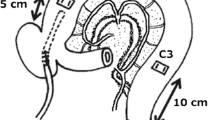Summary
-
1.
The effect of short tetanic stimulation (30 Hz for 25 s) on the following twitch responses of the myenteric plexus-longitudinal muscle preparation of guinea-pig ileum to electric stimulation (0.1 Hz) was investigated in the presence of naloxone and indomethacin.
-
2.
Post-tetanic potentiation (PTP) of the twitches observed in control experiments was abolished in preparations desensitized by substance P but it was not affected in preparations desensitized by serotonin or pretreated with methysergide.
-
3.
Immediately after 5 min tetanic stimulation a decreased sensitivity to substance P but unchanged sensitivity to serotonin were observed.
-
4.
Electromyogram (EMG) of the longitudinal muscle layer was picked up 4 and 10 mm aborally from the stimulation site in response to 1 to 16 impulse trains delivered at 100 Hz. In control conditions only the longer trains triggered this neurogenic response at the distal recording site. In the presence of substance P but not serotonin facilitation occured so that the distal site was frequently recruited to respond with an EMG even to single impulses.
-
5.
A substance P-like compound rather than serotonin may be a candidate for the neuromodulator or neurotransmitter substance involved in PTP and changes in the response topography of muscarinic transmission.
Similar content being viewed by others
References
Barthó L, Sebök B, Szolcsanyi J (1982) Indirect evidence for the inhibition of enteric substance P neurons by opiate agonists but not by capsaicin. Eur J Pharmacol 77:273–279
Bauer V, Kuriyama H (1982) The nature of non-cholinergic, nonadrenergic transmission in longitudinal and circular muscles of the guinea-pig ileum. J Physiol 332:375–391
Bergmann J, Oehme P, Bienert M, Niedrich H (1975) Studien zum Wirkungsmechanismus glattmuskulär angreifender Peptide. Acta Biol Med Germ 34:475–481
Chahl L (1983) Substance P mediates atropine-sensitive response of guinea-pig ileum to serotonin. Eur J Pharmacol 87:485–489
Costa M, Cuello AC, Furness JB, Franco R (1980) Distribution of enteric neurons showing immunoreactivity for substance P in the guinea-pig ileum. Neuroscience 5:323–331
Gershon MD (1981) The enteric nervous system. Ann Rev Neurosci 4:227–272
Ginsborg BL, Jenkinson DH (1976) Transmission of impulses from nerve to muscle. In: Zaimis E (ed) Neuromuscular junction. Springer, Berlin Heidelberg New York, pp 229–364
Gintzler AR (1980) Substance P involvement in the expression of gut dependence on opiates. Brain Res 182:224–228
Grafe P, Mayer CJ, Wood JD (1979) Evidence that substance P does not mediate slow synaptic excitation within the myenteric plexus. Nature 279:720–721
Hirst GDS, Redman SJ, Wong K (1981) Post-tetanic potentiation and facilitation of synaptic potentials evoked in cat spinal motor neurons. J Physiol 321:97–110
Holzer P (1983) Stimulus induced release of immunoreactive substance P from the myenteric plexus of the guinea-pig small intestine. In: Skrabanek P, Powell D (eds) Substance P. Book Press, Dublin, pp 243–244
Huidobro-Toro JP, Chelala CA, Bahouth S, Nodar R, Musacchio JM (1982) Fading and tachyphylaxis to the contractile effects of substance P in the guinea-pig ileum. Eur J Pharmacol 81:21–34
Johnson SM, Katayama Y, Morita K, North RA (1981) Mediators of slow synaptic potentials in the myenteric plexus of the guineapig ileum. J Physiol 320:175–186
Kadlec O, Mašek K, Šeferna I (1974) A modulating role of prostaglandins in contractions of the guinea-pig ileum. Br J Pharmacol 51:565–570
Kadlec O, Mašek K, Šeferna I (1978) Modulation by prostaglandins of the release of acetylcholine and noradrenaline in guinea-pig isolated ileum. J Pharm Exp Ther 205:635–645
Kadlec O, Mašek K, Šeferna I (1979) Post-tetanic potentiation in the innervated smooth muscle preparation of the guinea-pig ileum. Eur J Pharmacol 60:383–386
Kadlec O, Šeferna I, Mašek K, Somogyi GT, Knoll J (1982a) The analysis of post-tetanic potentiation in guinea-pig ileum longitudinal muscle strip. Eur J Pharmacol 79:245–255
Kadlec O, Šeferna I, Mašek K (1982b) The mechanism of posttetanic potentiation (PTP) at the neuromuscular junction of the guinea-pig ileum. Physiol Bohemoslov 31:448
Kadlec O, Šeferna I, Mašek K, Rů zička V (1983) Posttetanic potentiation at the neuromuscular junction of the guinea-pig ileum longitudinal muscle strip: Influence of calcium, temperature, ouabain and hexamethonium. Arch Int Pharmacodyn 261:122–132
Kadlec O, Mašek K, Šeferna I (1984a) The topography of posttetanic potentiation. Experientia (accepted for publication)
Kadlec O, Mašek K, Rů zička V, Šeferna I (1984b) Post-tetanic potentiation at the nerve muscle junction in the longitudinal muscle strip of guinea-pig ileum; possible role of prostaglandins. J Pharm Pharmacol 36:65–68
MacIntosh FC, Collier B (1976) Neurochemistry of cholinergic terminals. In: Zaimis E (ed) Neuromuscular junction. Springer, Berlin Heidelberg New York, pp 99–228
Magleby KL (1973) The effect of tetanic and post-tetanic potentiation on facilitation of transmitter release at the frog neuromuscular junction. J Physiol 234:353–371
Morita K, North RA (1981) Oplates and enkephalin reduce the excitability of neuronal processes. Neuroscience 6:1943–1951
North RA (1982) Electrophysiology of the enteric nervous system. Neuroscience 7:315–325
Paton WDM (1955) The response of the guinea-pig ileum to electrical stimulation by coaxial electrodes. J Physiol 127:40–41P
Paton WDM, Vizi ES, Zar MA (1971) The mechanism of acetylcholine release from parasympathetic nerves. J Physiol 215:819–848
Puig MM, Gascón P, Musacchio JM (1978) Electrically induced opiate-like inhibition of the guinea-pig ileum: Cross-tolerance to morphine. J Pharm Exp Ther 206:289–302
Stjärne L (1978) Facilitation and receptor-mediated regulation of noradrenaline secretion by control of recruitment of varicosities as well as by control of electrosecretory coupling. Neuroscience 3:1147–1155
Vane JR (1971) Inhibition of prostaglandin synthesis as a mechanism of action for aspirin-like drugs. Nature New Biol 231:232–235
Author information
Authors and Affiliations
Rights and permissions
About this article
Cite this article
Kadlec, O., Mašek, K. & Šeferna, I. Post-tetanic potentiation at the nerve-muscle junction in the longitudinal muscle of the guinea-pig ileum. Naunyn-Schmiedeberg's Arch. Pharmacol. 326, 262–267 (1984). https://doi.org/10.1007/BF00505328
Received:
Accepted:
Issue Date:
DOI: https://doi.org/10.1007/BF00505328



